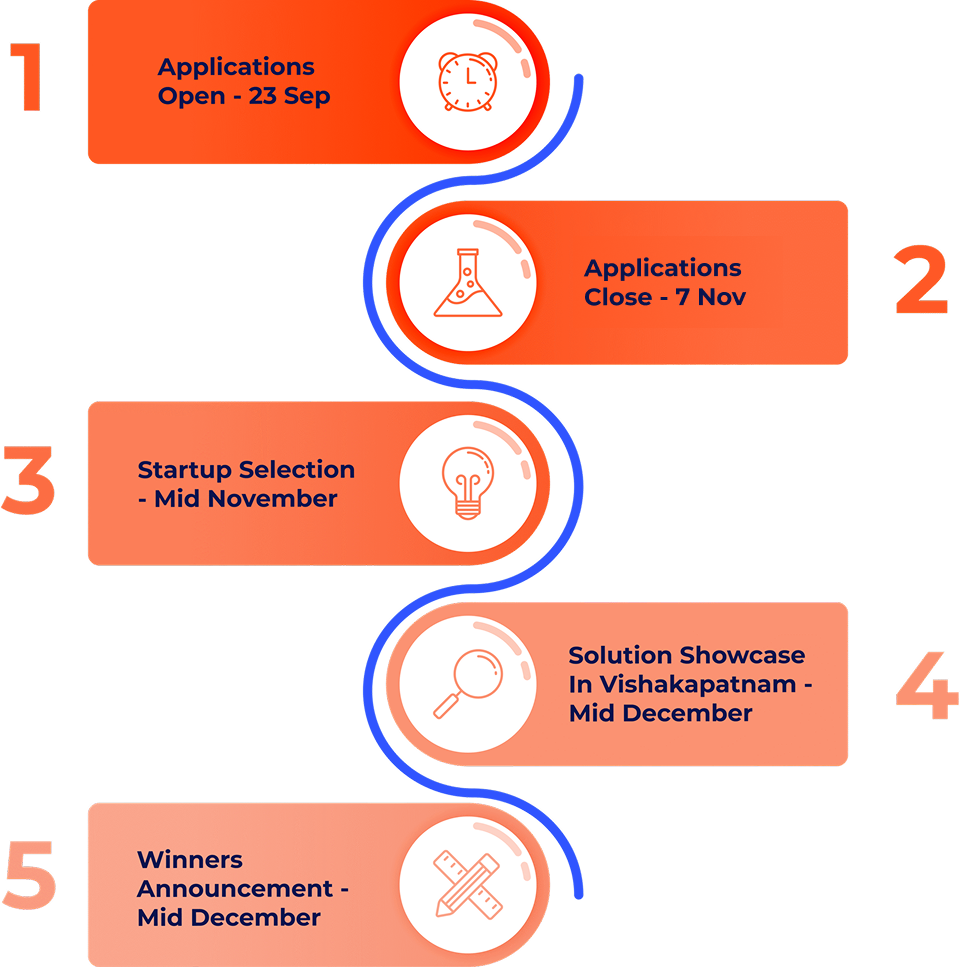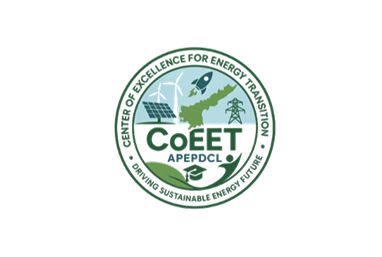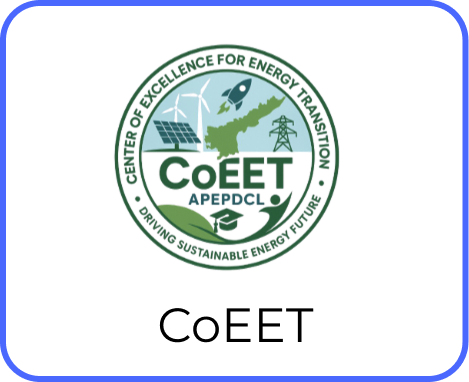-
- Program
- Events
- Case Studies
- Startup Hub
- FAQs
- About Us WooCommerce not Found
- Newsletter
About the Hackathon
The Centre of Excellence for Energy Transition (CoEET), APEPDCL and ElectronVibe announce HackAP Hackathon for the Power Sector. The hackathon invites startups to showcase their solutions that solve for real-world grid challenges in Andhra Pradesh.
Selected startups will present their solutions to key power sector leaders in Andhra Pradesh, with winning teams considered for potential pilots.
Program Overview
The hackathon is designed to address specific problem statements defined by our partner electric utilities:
- Problem Statement 1
- Problem Statement 2
- Problem Statement 3
- Problem Statement 4

Problem Statement 1: Enabling Predictive Maintenance through Grid Intelligence and Infrastructure Monitoring
Leveraging drone-based inspection, AI analytics, and performance-linked monitoring to transition AP DISCOMs from scheduled maintenance to predictive maintenance across grid and rooftop solar infrastructure
What is the Problem?
AP DISCOMs currently rely on time-based inspections and routine schedules to maintain their distribution infrastructure. This approach often leads to delayed fault detection, inefficient use of maintenance crews, and unplanned outages. To improve reliability and efficiency, there is a growing need to shift towards performance-based predictive maintenance—where assets are monitored continuously and maintenance is triggered based on risk, condition, or observed anomalies.
However, enabling predictive maintenance requires both data-driven tools and upgrades to grid infrastructure. There is currently limited visibility into asset condition, fault trends, and root causes of interruptions. Valuable insights from interruption data—such as the frequency of faults, duration, and category of faults, location of outages, seasonality conditions —are not yet being systematically analysed to inform preventive actions.
In parallel, rooftop solar adoption is accelerating, but installation quality issues are common and often go undetected. Poor wiring, inverter placement, or panel tilt can lead to reduced generation, safety risks, or grid disturbances. There is a clear need for scalable solutions that allow quality assessment of rooftop PV installations without physical inspections.
Potential Solutions
- Drone-based monitoring platforms for automated inspection of poles, lines, and transformers to detect physical wear, vegetation risk, or equipment damage.
- AI-powered interruption data analysis tools to identify recurring fault locations, failure patterns, and high-risk assets.
- Predictive maintenance dashboards integrated with grid asset databases to prioritise interventions based on performance trends.
- Digital tools for rooftop solar inspection using satellite/drone imagery and AI to assess installation quality and flag risky or underperforming systems.
- Condition monitoring systems that support the shift from fixed maintenance schedules to real-time, risk-based asset management.
- Improved asset life, reduced downtime, and increased grid reliability through smarter maintenance planning.
- Etc.


Problem Statement 2: Smart Meter Data Analytics for Revenue Protection
Using 15-minute interval smart meter data to detect anomalies, reduce revenue leakage, and improve billing integrity across the AP DISCOM consumer base
What is the Problem?
As smart meters are deployed across Andhra Pradesh, DISCOMs are generating vast amounts of granular consumption data. However, this data is not yet fully leveraged to identify abnormal patterns, potential theft, or billing issues. Revenue leakage continues to be a challenge, especially due to theft or pilferage.
There is a strong need for smart, automated systems that can process high-frequency meter data, detect unauthorised usage, and flag potential losses in real time supporting faster action and improved revenue assurance.
Potential Solutions
- Anomaly detection programs that analyse 15-minute consumption data to flag tampering, leakage, or bypass events.
- Dashboards and heatmaps that help DISCOM teams identify leakage-prone areas and target inspections more efficiently.
- Automated alerts and case management systems triggered by consumption anomalies.
- Improved transparency and reduced non-technical losses through proactive detection and action.
- Etc.


Problem Statement 3: Transformer Failure Prediction through Integrated Grid Data
Improving transformer reliability by analysing smart meter and outage data to detect failure patterns and guide preventive maintenance
What is the Problem?
Power and distribution transformer failures continue to be a major cause of downtime in the AP distribution network. Today, root cause analysis is largely reactive, and transformers are replaced after failure often without understanding long-term patterns of stress, loading, or faults.
DISCOMs now have access to OMS logs and smart meter data, but this information is not yet being used systematically to predict transformer failures. There is a clear opportunity to use AI-based tools to correlate outage and performance data, generate health scores, and guide targeted maintenance or replacement.
Additionally, failure events may be linked to upstream or downstream issues across the network—such as low-voltage faults, feeder imbalances, or poor load management—which require co-relation analysis to uncover hidden dependencies or cascading fault patterns.
Potential Solutions
- AI models/ IOT based tools that combine transformer loading, temperature, and fault history to identify likely causes of failure.
- Predictive health scoring systems to rank transformers based on risk and age.
- Integration with OMS and asset databases to trigger maintenance plans automatically.
- Reduced downtime, better asset planning, and extended transformer lifespan.
- Etc.


Problem Statement 4: Detection of Insulator Failures on HT Lines
Developing advanced sensing to detect insulator faults safely and accurately during both day and night operations
What is the Problem?
Failure of insulators on high-tension (HT) lines is one of the leading causes of power supply interruptions across AP DISCOMs. These failures—often due to cracks, contamination, or material degradation—are difficult to detect through manual inspection, especially across large or remote sections of the grid.
Currently, when an insulator fault occurs, field teams must carry out manual sectionalizing, checking line sections one by one to isolate the issue. This process is slow and delays fault resolution. The problem is especially complex during night-time, when reduced visibility and safety concerns further complicate detection.
There is a need for non-contact, portable, or remotely deployable tools that can detect insulator faults in real-time, helping DISCOMs respond faster and reduce outage durations.
Potential Solutions
- Advanced sensing tools (e.g., optical, thermal, UV, or acoustic) mounted on ground equipment or drones to detect abnormal conditions in insulators.
- AI-powered image or signal analysis to identify cracks, contamination, or electrical discharge in porcelain and polymer insulators.
- Portable diagnostic devices to support field personnel in rapid fault location without manual sectionalizing.
- Faster fault isolation, improved safety, and reduced power supply interruptions across HT infrastructure.
- Etc.

Who Can Participate?
We invite deployment-ready startups whose innovations can bring scalable technological solutions, addressing the specific problem statements for the power sector in Andhra Pradesh.
Why Should You Apply?

Post Program Pilot
The winning startup will be considered for a pilot opportunity with the partnering electric utilities in Andhra Pradesh.

Networking
Access to a wide range of stakeholders in the power sector, including startups and power sector experts.

Opportunity to Engage
Opportunities to meet and engage with the AP electric utility professionals and other power sector stakeholders at the Hackathon in Vishakapatnam.
Timeline

About
The Centre of Excellence for
Energy Transition (CoEET)
The Centre of Excellence for Energy Transition (CoEET) aims to build awareness in the power sector area, provide training and capacity building along with supporting research and development. This Centre serves the purpose of hand holding discoms in navigating the challenges of the energy transition.


About
ElectronVibe
ElectronVibe is an open-innovation program for electric utilities, via which a cohort of mature power-sector startups co-develop business cases for scalable technological innovations, with the aim of implementing pilot-projects as a precursor to larger deployment. The program is powered by New Energy Nexus.
About
Climate Collective Foundation
Climate Collective Foundation, founded in 2018, builds integrated climate tech startup ecosystems across the Global South. The organization has built the country's largest climate tech support platform, demonstrating deep expertise in fostering climate innovation and entrepreneurship.








